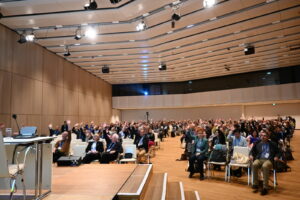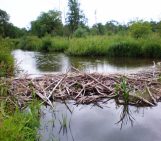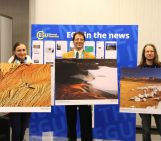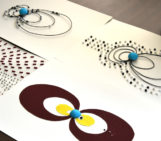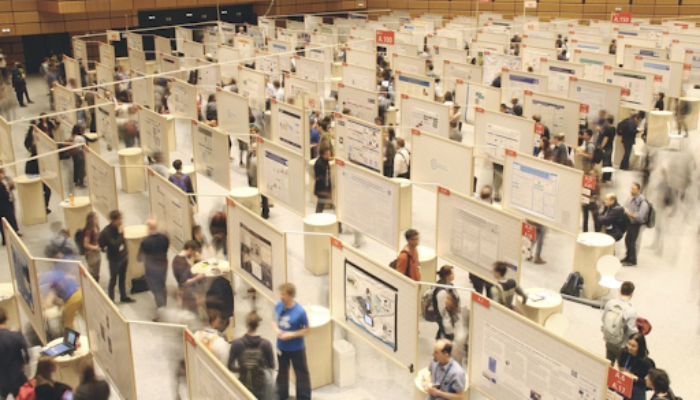
The wind, funnelled downwards by the surrounding skyscrapers, whipped along Wagramer Strasse, as early morning traffic thundered by. Past the Orthodox Church and then slightly uphill to the Kaisermühlen VIC underground station, where a stream of one-way traffic was already in full force, everybody proudly displaying their blue lanyards and most carrying the large black poster tubes that are so indicative of a scientific conference. Past the Imbisstand, already with a queue 10-deep as people waited for their first coffee of the day, then up the hill to the undercover glass walkway. Then, finally, like a light at the end of the tunnel, the big blue sign declaring “EGU General Assembly – Welcome.”
It was good to be back.
This was not my first, or even tenth, time at the European Geosciences Union’s General Assembly, the biggest geoscience conference in Europe; according to their website, this year boasted an impressive 18,831 attendees, ~82% of which attended in person from 107 countries. I first came here in 2007, and have been making the annual pilgrimage – usually over land to avoid the carbon-guzzling flight – mostly ever since. I missed the Assembly from 2016-2019, which was a shame but unavoidable, and always promised myself I would return.
We all know what happened next, in 2020.
Fast forward a couple of years, and most of us had necessarily become accustomed to virtual meetings and conferences, some of us more willingly than others. Personally I quite like virtual attendance, firstly for its practical ease and secondly to cut down on international travel, but many of my colleagues disagree and say that face-to-face is infinitely better. Certainly virtual attendance has its drawbacks, but when it is done well, I find it just as enjoyable; indeed I wrote a blog post for the Cabot Institute last year, extolling the virtues of a very successful hybrid meeting. That meeting, however, was comparatively small (only ~100 participants), not the mammoth undertaking that is EGU. Despite my preference for virtual attendance, and in spite of my continued nervousness about COVID, I decided the time had come to leave my computer screens and interact in 3D with other human beings, and so found myself on the other side of the camera, in Vienna.
The Assembly, pleasingly, hadn’t changed dramatically or lost any of its charm since my last visit in 2015. The main entrance, hallway and exhibitors gallery were the same, the posters were still in several large halls either in a separate building or on a lower floor of the main building, and the lecture halls remained the same. New to me was the mentoring programme, and as a seasoned EGU participant I volunteered my services to be a mentor; I ended up being paired with three early career scientists (ECS), one of which attended virtually and the others were there in person. This turned out to be a huge success, at least from my perspective – I very much hope I was of some use to them as well. I met all of them virtually before the Assembly began, to discuss their experiences and what they wanted to get out of the scheme (and me), and we then met up on several occasions throughout the week. Indeed, most of my first day was spent either judging posters for the OSPP, or spending time with my mentees.
In terms of the lectures, most of my time (and indeed my own session) was spent in one of the larger lecture halls,
and this was a bonus for two reasons. Firstly in terms of getting a larger audience and potentially speaking to a more diverse group of people not constrained by a lack of seating. To my surprise, when I arrived the morning of my talk I found a lift/raising platform from the floor to the large elevated stage; something that, as a wheelchair user, was enormously appreciated, allowing me to access the podium (and the camera for the online participants) like everyone else. In previous years this has not been available, and I have had to deliver my talk from ground level which, although acceptable, was never ideal. The hybrid nature of the lectures seemed to work very well, from my side of the camera at least, and those people joining virtually either delivered their presentations live or provided a pre-recorded talk. The EGU operator, sitting at the front, skilfully loaded up each presentation and advanced all of our slides, seamlessly fielding questions from both us in the audience and those online, such that everybody could hear everybody else speak (more or less – the acoustics meant that some questions from the live audience was sometimes difficult to hear).
The second reason I enjoyed spending most of my time in the larger lecture halls was the increased space. I completely understand that for most people, COVID is a thing of the past and no longer something to worry about. For some of us, however, it is very much still present, and after over two years of self-isolating, finding myself back in the crowded EGU environment was a little nerve-racking. I was okay in the larger lecture halls, but confess that I was rather uncomfortable during the few sessions I attended that were held in one of the smaller seminar rooms, where people crowded together in very close proximity. In future years I would like to see slightly better planning in terms of room allocation; I realise that this is difficult in a finite physical space, but I would like a better estimation of the expected number of people for any given session, to avoid over 100 people squashing into a room designed to hold less than 50. The only other time I felt distinctly uncomfortable was upon leaving the main conference building, either at lunchtime or at the end of the day; an extremely crowded, slowly moving crush of people as we were all squeezed through the main entrance. I can’t remember the last time I was that close to so many people, but it was certainly well before the pandemic. I appreciate that bottlenecks are inevitable when that many people leave at the same time, but in future I would like to see slightly better crowd control such as staggering the end times of sessions, or allowing more/other exits.
All in all, it was a very enjoyable week, and EGU has clearly evolved well over the years, not least in response to everything that has happened since 2020. Amazingly, given that the world was in full panic-mode in April 2020, there was actually an Assembly that year, planned as normal and then translated to be entirely online at the very last hour. The year after was the same; in my opinion, both of these virtual Assemblies worked very well, with a large virtual lobby (which remarkably resembled the real thing) and a spider’s web of Zoom breakout rooms. The year after, 2022, by which time travel restrictions had eased for most, was the first proper EGU hybrid event, and saw a return of many in person attendees. The hybrid format was deemed so successful that it was decided that all General Assemblies going forward would be like this, something which I entirely back for the reasons discussed above. In 2022, for example, I decided to again attend virtually, and from my private side of the camera at home, this worked equally well if not better than the fully virtual events of the previous two years; I was able to deliver my science almost as if I was there in person.
Almost.
This year, I therefore braved the interaction with real-life humanity, and was comforted to find that, in a world which continues to be full of uncertainty, EGU at least remains a reliable constant.


